
Montmartre is a large hill in Paris's northern 18th arrondissement. It is 130 m (430 ft) high and gives its name to the surrounding district, part of the Right Bank. Montmartre is primarily known for its artistic history, for the white-domed Basilica of the Sacré-Cœur on its summit, and as a nightclub district.
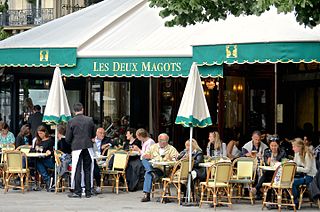
The 6th arrondissement of Paris is one of the 20 arrondissements of the capital city of France. In spoken French, it is referred to as le sixième.
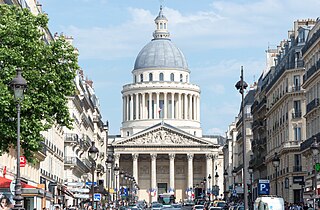
The 5th arrondissement of Paris is one of the 20 arrondissements of the capital city of France. In spoken French, this arrondissement is referred to as le cinquième.

Charles Aznavour was a French singer of Armenian ancestry, as well as a lyricist, actor and diplomat. Aznavour was known for his distinctive vibrato tenor voice: clear and ringing in its upper reaches, with gravelly and profound low notes. In a career as a composer, singer and songwriter, spanning over 70 years, he recorded more than 1,200 songs interpreted in 9 languages. Moreover, he wrote or co-wrote more than 1,000 songs for himself and others. Aznavour is regarded as one of the greatest songwriters of all time and an icon of 20th-century pop culture.

Antoine Bourdelle, born Émile Antoine Bordelles, was an influential and prolific French sculptor and teacher. He was a student of Auguste Rodin, a teacher of Giacometti and Henri Matisse, and an important figure in the Art Deco movement and the transition from the Beaux-Arts style to modern sculpture.
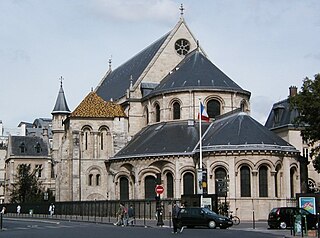
The 3rd arrondissement of Paris is one of the 20 arrondissements (districts) of the capital city of France. In spoken French, this arrondissement is colloquially referred to as "le troisième" meaning "the third". Its postal code is 75003. It is governed locally together with the 1st, 2nd and 4th arrondissements, with which it forms the 1st sector of Paris, Paris Centre.
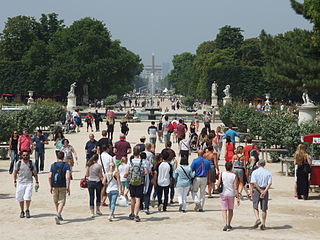
The Tuileries Garden is a public garden between the Louvre and the Place de la Concorde in the 1st arrondissement of Paris, France. Created by Catherine de' Medici as the garden of the Tuileries Palace in 1564, it was opened to the public in 1667 and became a public park after the French Revolution. Since the 19th century, it has been a place for Parisians to celebrate, meet, stroll and relax. During the 2024 Summer Olympics and Paralympics, it was the site of the Olympic and Paralympic cauldron.

The Jardin du Luxembourg, known in English as the Luxembourg Garden, colloquially referred to as the Jardin du Sénat, is located in the 6th arrondissement of Paris, France. The creation of the garden began in 1612 when Marie de' Medici, the widow of King Henry IV, constructed the Luxembourg Palace as her new residence. The garden today is owned by the French Senate, which meets in the palace. It covers 23 hectares and is known for its lawns, tree-lined promenades, tennis courts, flowerbeds, model sailboats on its octagonal Grand Bassin, as well as picturesque Medici Fountain, built in 1620. The name Luxembourg comes from the Latin Mons Lucotitius, the name of the hill where the garden is located, and locally the garden is informally called "le Luco".

The Boulevard Saint-Michel is one of the two major streets in the Latin Quarter of Paris, France, the other being the Boulevard Saint-Germain. It is a tree-lined boulevard which runs south from the Pont Saint-Michel on the Seine and Place Saint-Michel, crosses the Boulevard Saint-Germain and continues alongside the Sorbonne and the Jardin du Luxembourg, ending at the Place Camille Jullian just before the Port-Royal RER station and the Avenue de l'Observatoire. It was created by Baron Haussmann to run parallel to the Rue Saint-Jacques which marks the historical north-south axis of Paris. It is known colloquially as Boul'Mich' in French.

The Musée Bible et Terre Sainte, also known as the Musée Biblique, is a small museum operated by the Institut Catholique de Paris, and located in the 6th arrondissement of Paris, France, at 21 rue d'Assas. It is open Saturday afternoons; admission is free.

The Musée Bourdelle is an art museum located at 18, rue Antoine Bourdelle, in the 15th arrondissement of Paris, France, located in the old studio of French sculptor Antoine Bourdelle (1861–1929). The museum is open daily, except Mondays. Admission to the permanent collections is free. The nearest metro stations are Falguière and Montparnasse-Bienvenüe.
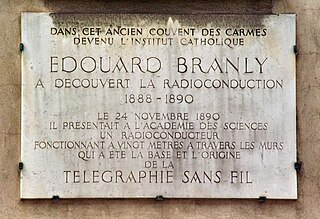
The Musée Édouard Branly is a museum dedicated to the work of radio pioneer Édouard Branly (1844―1940). It is located in the 6th arrondissement at the Institut Catholique de Paris-ISEP, 21, rue d'Assas, Paris, France, and open by appointment only.

The Musée Zadkine is a museum dedicated to the work of Russian sculptor Ossip Zadkine (1890–1967). It is located near the Jardin du Luxembourg in the 6th arrondissement at 100 bis, rue d'Assas, Paris, France, and open daily except Monday; an admission fee is only charged during exhibitions. The museum also contains a fine garden, with no charge for entry. The nearest métro and RER stations are Port-Royal and Vavin.

Jean-Baptiste Auguste Clésinger was a 19th-century French sculptor and painter.
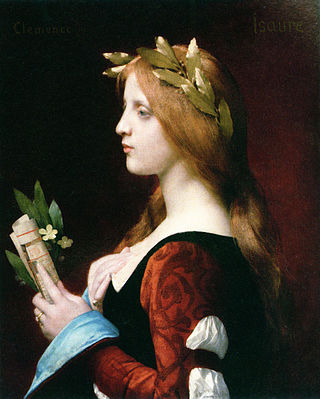
Clémence Isaure is a quasi-legendary Occitan medieval figure credited with founding or restoring the Acadèmia dels Jòcs Florals or Academy of the Floral Games. She is supposed to have left a legacy to fund awards in the form of gold and silver flowers that the city of Toulouse would award annually to the best poets.

The Rue Bonaparte is a street in the 6th arrondissement of Paris. It spans the Quai Voltaire/Quai Malaquais to the Jardin du Luxembourg, crossing the Place Saint-Germain-des-Prés and the Place Saint-Sulpice and has housed many of France's most famous names and institutions as well as other well-known figures from abroad.

Paul Albert Laurens was a French painter.

The Carmes Seminary is a university seminary within the Institut Catholique de Paris, in Paris, France. It was founded in 1919 and now houses more than fifty Roman Catholic seminarians from several French dioceses.
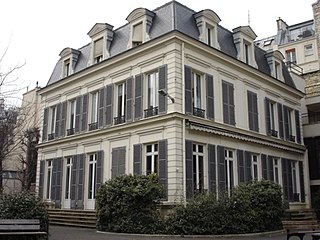
The École alsacienne is a co-educational private school located in the 6th arrondissement of Paris.

Victor Chocquet was a French art collector and an ardent propagandist of Impressionism. As a senior editor at the Directorate-General of Customs and Indirect Taxes, he was present at all the exhibitions where he defended painters confronted with mockery and insults. His collection was huge. It was dispersed after his death in 1899. Many of the paintings are currently in American museums.





















